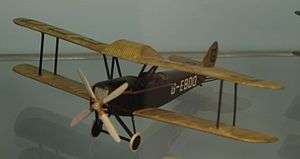de Havilland DH.37
| DH.37 | |
|---|---|
 | |
| Scale model of the DH.37A, G-EBDO, on display at the Shuttleworth Collection | |
| Role | Private biplane |
| Manufacturer | De Havilland |
| First flight | June 1922 |
| Number built | 2 |
The de Havilland DH.37 was a British three-seat sporting biplane of the 1920s designed and built by de Havilland for Alan Samuel Butler. The first —named Sylvia after Butler's sister[1]— of the two examples built flew extensively for five years before being converted to a single-seater and having its engine upgraded to a 300 hp (224 kW) A.D.C. Nimbus . It crashed in June 1927.
The second aircraft was sold to Australia, and was flown by the Controller of Civil Aviation. Sold to the Guinea Gold Company in New Guinea, it was the first aircraft flown in that country. After a forced landing at Wau aerodrome in December 1937 it was put out of commission.[2]
Specifications (DH.37)
General characteristics
- Crew: 1
- Capacity: 2
- Length: 28 ft 0 in (8.53 m)
- Wingspan: 37 ft 0 in (11.28 m)
- Wing area: 398 ft2 (36.97 m2)
- Empty weight: 2,118 lb (961 kg)
- Gross weight: 3,318 lb (1,505 kg)
- Powerplant: 1 × Rolls-Royce Falcon III inline piston engine, 275 hp (205 kW)
Performance
- Maximum speed: 122 mph (196 km/h)
- Service ceiling: 21,000 ft (6,400 m)
References
- ↑ Mr Alan Butler. Obituary, The Times, Wednesday, May 27, 1987; pg. 18; Issue 62779
- ↑ Lloyd Rhys, High Lights and Flights in New Guinea, London: Hodder & Stoughton, 1942, p. 151.
| Wikimedia Commons has media related to De Havilland DH.37. |
- Donald, David, ed. (1997). The Encyclopedia of World Aircraft. Prospero Books. p. 312. ISBN 1-85605-375-X.
This article is issued from
Wikipedia.
The text is licensed under Creative Commons - Attribution - Sharealike.
Additional terms may apply for the media files.